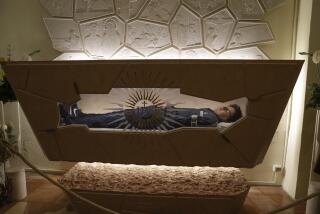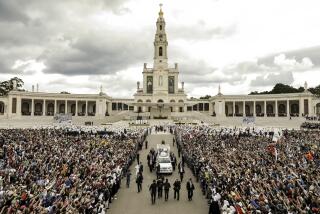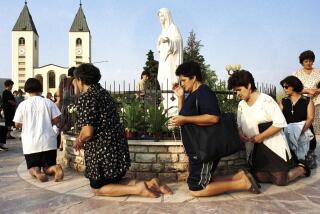Confirming Miracles Is Art and Science
VATICAN CITY — Cancer is cured. Bleeding is stopped. Third-degree burns vanish overnight.
These and many, many more examples are on record as authenticated miracles that are the essential -- and most unusual -- step in the naming of a saint by the pope, leader of the world’s Roman Catholic Church.
John Paul II, who on Thursday marks 25 years as pontiff, has set the record for canonizing saints and beatifying potential saints. He has given the title to more people than all his predecessors in the last four centuries combined, according to Vatican statistics: 476 saints as of Oct. 5.
On Sunday, the pope will add to the roster of “the blessed” by beatifying Mother Teresa of Calcutta, the petite nun with the white-and-blue sari whose ascent has generated a bit of controversy, because of both its unprecedented swift pace and questions about the miracle included in her dossier.
It is in the field of miracles, however, that the church’s medieval traditions intersect with the modern edifices of science and knowledge. In some ways, it is the miracle that most tests one’s faith.
“There is always an element of faith where science ends and faith takes over,” said Monsignor Robert J. Sarno, an official with the Congregation for the Causes of Saints, the Vatican office that investigates the cases of potential saints.
“We have to be courageous enough to admit that science is not the only truth in human existence,” said Sarno, a New Yorker who has been doing this kind of work for 22 years. “While it plays an essential part, it doesn’t explain all human reality ... [and] it does not satisfy all human needs.”
The requirements for sainthood are specific, and the men who prepare and authenticate the cases are meticulous and serious. “We have nothing to do with crying statues,” Sarno said.
In a dusty library on the third floor of the Vatican’s Congregation for the Causes of Saints, just off St. Peter’s Square, row after row of shelves hold thousands and thousands of documents attendant to the claims of holiness going back centuries.
To be considered, candidates for beatification and sainthood -- they are known as servants of God -- must have widespread reputations for holiness that have grown and deepened years after their death.
And they must be known to have “intercessionary” powers. That means a believer can pray to the candidate requesting intercession with God to grant a favor, which may be the cure of a serious medical problem.
Those two points established, supporters of a particular servant of God embark on a long and expensive lobbying campaign that includes the accumulation of documents and eyewitness reports establishing that the candidate lived a life of “heroic Christian virtue.”
Then comes the miracle.
In 1983, under John Paul’s guidance, the process of beatification and canonization was streamlined to allow people to become saints more quickly. The pope, aides say, wanted to make saints a larger and more diverse group to show that holiness is within the reach of all good Catholics. Critics said the changes, including the elimination of the devil’s advocate, whose role was to challenge each candidate and force greater scrutiny, allow for political manipulation of the process.
Among the reforms was a significant reduction in the number of miracles required. People who are “martyrs” -- killed because of their Catholic faith -- can be beatified without a miracle and then need just one miracle to become a saint. Others need two, one to be beatified, a second to make the final leap to sainthood.
Miracles almost always involve cures in part because many of Jesus Christ’s miracles were related to healing. Also, Sarno said, it is when one is sick or dying that one most likely prays to God for help.
At the midpoint of the last century, the Vatican established a medical board, the Consulta Medica, consisting of about 100 prestigious doctors who are asked to examine the cures. To be considered miraculous, a cure -- coming after the believer has prayed to the potential saint -- must be instantaneous or sudden, complete and permanent, and without scientific explanation.
Dr. Raffaello Cortesini, a heart-transplant specialist who served as president of the board for two decades until retiring last year, has seen, he believes, many a miracle. Of about 500 cases he reviewed in his long career with the Consulta, roughly half have met the criteria for miraculous cures.
He’s seen cases of tumors that vanished and cerebral lobes that regenerated, he said. Cervical cancer cured overnight. Expired hearts and brains jumping back to life.
“It’s really impressive,” he said in a telephone interview from New York, where he is working at Columbia University hospital. “Every time, we try to find an explanation, but we don’t.”
Ironically, they use the latest medical techniques to substantiate something that is as far from modern science as can be. They pore over CT scans, pharmaceutical regimes and medical reports supplied by physicians who treated the person allegedly healed by the miracle.
On average, five Consulta Medica doctors examine a case, and three of the five must agree that the criteria are met. Cortesini noted that most cases that reach the Consulta Medica have already been thoroughly screened, thus the relatively high rate of approval by his board.
The doctors do not utter the word “miracle,” however. That is a theological determination, not a medical one. They simply judge whether the cure is complete and without scientific explanation. Next, a panel of theologians, cardinals and priests establishes that the cure came as a result of someone praying to the candidate.
Cortesini, 72, reviewed and approved the case of a girl in Massachusetts a few years ago who swallowed a bottle of Tylenol and lapsed into a coma with a damaged liver. Awaiting a possible liver transplant but fast losing hope, the girl’s family prayed to Edith Stein. The lesions on the girl’s liver disappeared, according to the case literature, and she recovered completely.
Stein, a Jew who converted to Catholicism and was killed in a Nazi concentration camp, was canonized five years ago this month. The sainthood granted Stein, who became Teresa Benedict of the Cross, has been roundly criticized by Jewish groups who contend that she was killed not because of her Catholicism but because of her Judaism, which the canonization obscures.
Cortesini was also impressed by the case of a Chilean firefighter who was electrocuted in an accident. He was pronounced dead, his heart and brain apparently stopped. When his family prayed to Juana Fernandez Solar, he abruptly came to, unscathed. Solar, who died in 1920, was beatified in 1987 and became St. Teresa de Jesus de los Andes in 1993.
Noting that many of the medical reports that reach the Consulta are by non-Catholic doctors (though all members of the Consulta are Catholic), Cortesini said he is convinced the board is able to eliminate cases of hysteria, or psychosomatic conditions, and is dealing with truly sick people who became well in ways inexplicable by science.
“It is not a matter of imagination or illusion,” the doctor said. “You are at the border of reality. You are somewhere between the natural and supernatural. You can touch the supernatural.”
This might seem odd talk coming from a man of science. But he and other members of the board seem comfortable, even satisfied, with their role in promoting saints. They see no contradiction between science and faith.
Quite the contrary, said Dr. Patrizio Poliska, a cardiologist who has served on the board for 15 years. “Faith and science can coexist in harmony,” he said in an interview at Rome’s European Hospital, where he practices. “I can understand [the skepticism], but speaking as a Christian man I must refer to the New Testament, and there, the miracles of Jesus are written. It’s not a joke.”
Cortesini was on the panel that judged the miracle attributed to Mother Teresa, who died in 1997 at the age of 87. It involves a Bengali tribal woman named Monica Besra from a remote east Indian village who was reputedly suffering from an ovarian tumor so awful and huge that she could no longer eat or drink.
Sent to die in 1998 at a hospice founded by Mother Teresa’s Missionaries of Charity, Besra was attended by two nuns who placed a medallion with Teresa’s image against her sick abdomen. Besra recovered, and the tumor disappeared. “This is divine intervention,” Cortesini said.
Others are not so sure, especially in Besra’s home region. At least one of her doctors has said she received extensive medical treatment that should be credited with shrinking the tumor. Even her husband initially told interviewers that he doubted the miracle -- although he has more recently come on board.
Admired enormously by the pope and internationally famed, Mother Teresa is on the fast track. Normally five years must pass after the candidate’s death before the beatification process can begin, and the process itself usually takes many more years. John Paul ordered that an exception be made, and she will be named “blessed” in record time. In fact, there was a movement, ultimately squashed, that advocated skipping beatification and elevating her straight to sainthood.
Even so, Teresa’s supporters have worked endlessly to compile a complete volume of records documenting her case. More than 100 witnesses answered a 263-question survey, and a 35,000-page, 80-volume report was assembled, according to the promoter of her cause, Father Brian Kolodiejchuk.
In addition to his enormous slate of saints, John Paul has beatified more than 1,300 people. They are a diverse bunch, including, for the first time, a lay couple. They are eligible for sainthood, but another miracle, performed after the date of beatification, must be authenticated first.
Junipero Serra, the Franciscan friar who founded California’s system of missions in the 18th century, was beatified in 1988 on the strength of what was judged to be the miraculous recovery from lupus by a nun in St. Louis who prayed for his intercession.
The pope beatified Marija of Jesus Crucified, a Croatian nun, after a Peruvian submarine captain whose vessel was sinking prayed to her for salvation. The ship was saved in what the Vatican certified was a miracle.
Josemaria Escriva de Balaguer, founder of the ultraconservative and powerful Opus Dei sect, was made a saint last year, in record time; the miracle attributed to him involved a Spanish physician, Manuel Nevado, who in 1992 prayed to Escriva for help and was cured of an otherwise-incurable form of skin cancer known as chronic radiodermatitis.
Aware that many skeptics see all of this as little more than hocus-pocus, some priests downplay the critical role of miracles in judging a potential saint’s qualifications.
“Miracles are not the essence, they are an accidental element,” said Father Peter Gumpel, a Jesuit priest who has worked in the Congregation for the Causes of Saints for 40 years, half of them as a relator, a kind of overseer. “We concentrate on the life. The miracle is the confirmation.”
A divine confirmation, he added, that gives the congregation an assurance that it hasn’t missed something when it judges a servant of God fit to become a saint.
More to Read
Sign up for Essential California
The most important California stories and recommendations in your inbox every morning.
You may occasionally receive promotional content from the Los Angeles Times.











